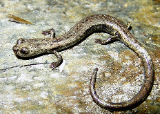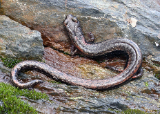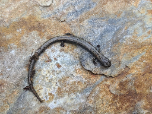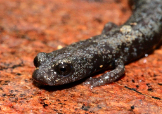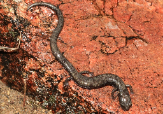 |
Fairview Slender Salamander Range Map

|
|
|
 |
 |
 |
 |
 |
 |
 |
Fairview Slender Salamander Juvenile
Want to Contribute a photo of a Juvenile Fairview Slender Salamander?
Email Us
|
|
|
 |
 |
 |
 |
 |
 |
|
Fairview Slender Salamander (Batrachoseps bramei)
Description: Females average 1.4 inches in length from snout to vent, males average of 1.35 inches in length. A small slender salamander with a relatively broad flattened head and long legs with relatively large feet. The tail is relatively short and rarely exceeds the total body length.
Short limbs, a narrow head, long slender body, very long tail, and conspicuous costal and caudal grooves give this species the worm-like appearance typical of most Slender Salamanders. This species is relatively large and robust when compared with many Slender Salamanders, having a comparitively broader head, longer legs, broader feet, and larger toes. There are four toes on the front and hind feet, which is also typical of Slender Salamanders. (Other California salamanders have five toes on the hind feet.) Has 1-3 fewer trunk vertebrae, a longer broader head, and larger limbs with larger feet than neighboring B. simatus. Color is black to brownish black, with silvery to gold or brassy metallic speckles. Coloring may give the appearance of a dorsal stripe. Uniformly flat black underneath with metallic speckling.
Habitat: Favors north-facing talus-covered slopes in narrow canyons. These areas typically do not get sun in winter and remain moist and cool into the spring.
Range: Endemic to California. Found only in the Upper Kern River Canyon along the west side of Lake Isabella, on the east and west sides of the river, from Wofford Heights north to 1 kilometer north of where South Falls Creek flows into the Kern River. May be found to range farther north where surveys have not been thorough.
Found in these States:
CA
Diet: Probably eats a variety of small invertebrates. Feeding behavior is not well known, but other Batrachoseps species are sit-and-wait predators that use a projectile tongue to catch prey.
Reproduction: Reproduction is terrestrial. Nothing is known of the reproduction of B. bramei. Like other low to mid- elevation Slender Salamanders, it is assumed that this species lays eggs on land between December and February, depending on stimulation by rainfall, which varies year to year.
Young presumably hatch in early spring, fully formed.
»» Kingdom: Animalia - Animals
»» Phylum: Chordata - Chordates
»» Subphylum: Vertebrata - Vertebrates
»» Class: Amphibia - (Amphibians)
»» Order: Caudata - Salamanders
»» Family: Plethodontidae - Lungless Salamanders
»» Genus: Batrachoseps
»» Species: Batrachoseps bramei - Fairview Slender Salamander
This article uses material from the Wikipedia article "Slender Salamander", which is released under the Creative Commons Attribution-Share-Alike License 3.0. Content may have been omitted from the original, but no content has been changed or extended.
|
|



